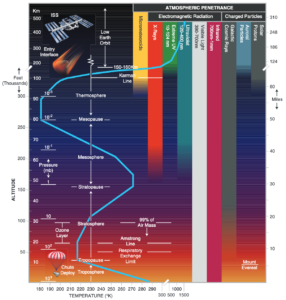Types of radiation in space
There are two sources of space radiation:
- the Sun
- Galactic Cosmic Rays (remnants of supernova explosions)
The Sun radiates mostly protons (positively charged particles), photons (X-rays, UV), ions of higher mass and radio-frequency emissions in the form of the plasma (ionised gas flow), called the Solar Wind, that can be relatively slow (300-550 km/s) or fast (650-900 km/s). 99% of the particles escaping the photosphere (the visible surface of the Sun) are protons (H+, positively charged Hydrogen ion) and Alpha particles (He++, positively charged Helium ions). As the Solar Wind has a direction, this radiation is non-isotropic.
Solar Flares (explosions caused by the violent release of energy stored in twisted magnetic fields around sunspots), Coronal Mass Ejections (giant bubbles of hot plasma escape at high velocity) and Solar Particle Events mean bigger eruptions that would result in higher-energy particle fluxes carried by faster winds.

The Solar Wind, once reaching Earth, interacts with the magnetic field, creating the magnetosphere which deflects most of the particles and traps some (Van Allen Belt). The magnetic field lines facing the Sun get compressed by the Solar Wind, and those facing away stream backwards to form Earth’s magnetotail. The weakest part of our magnetic field is at the poles therefore, when charged particles from the Sun ripple through Earth’s magnetosphere, some of those particles get through at the poles and collide with atoms in our atmosphere in 100-300 km, creating Aurora Borealis.
While the Galactic Cosmic Rays (GCRs) are responsible for isotropic (has no specific direction) ionising radiation. When we talk about GCRs we mean heavy, high-energy ions of elements, nuclei of atoms (stripped of their electrons) travelling with the speed of light. Creating the most biologically damaging radiation as they alter materials by removing electrons from the matter.
The majority of GCR consists of protons but apart from sub-atomic particles, it also contains UV, gamma and X-rays. Extragalactic Cosmic Rays and Ultra-High Energy Cosmic Rays happen rarely but could come from the Milky Way.
Fortunately, our atmosphere gradually filters out GCRs and they are stopped around the tropopause (8-10km from the surface, between the troposphere and stratosphere, see figure 1).

However, once we leave the protective environment of our atmosphere GCRs are a serious concern.
Our paper on the Architectural approach for evaluation of radiation shielding integration in space habitats was presented at the 74th IAC in Baku in 2023 and after a peer-review it is being published by Acta Astronautica.
In deep space, we need to consider both of these sources when addressing radiation protection and on the Moon, as it does not have an atmosphere, both radiation sources are bombarding the regolith. However, on the Mars surface, the radiation level is much lower (still not in a healthy region).
For comparison let’s look at Dr. Thomas Berger’s table from a presentation in 2022. (presentation at ISU 04/02/2022)
| From surface | Dose -µSV/hour | ||
|---|---|---|---|
| Earth | 50 m | ~0.1 | x1 |
| Mountain | 3 km /1.86 miles | ~0.2 | x2 |
| Airplane | 10 km /6.21 miles | ~4 | x40 |
| ISS | 420 km /261 miles | ~25 | x250 |
| Deep space | >38000 km />23612.1 miles | ~77 | x770 |
| Mars | 224 Gm (224000000 km) / 139187147.06 miles | ~26 | x260 |
We can shield ourselves against Alpha particles (He++) just with a sheet of paper or textile, while Beta particles require a little more, a centimetre of plastic or aluminium, however, Gamma particles can penetrate all of those and only lead, thick steel or thick concrete can stop them. Neutrons on the other hand need even more to be stopped, usually a layer of water.
Neutron is a subatomic particle (like a proton) with a neutral charge and a mass slightly bigger than a proton.